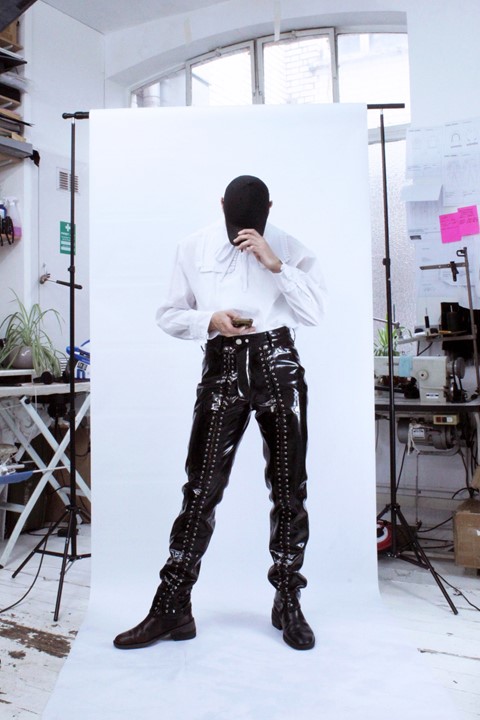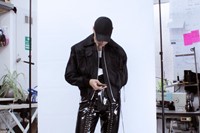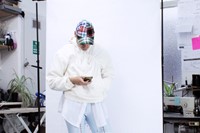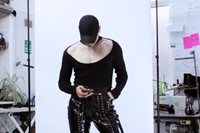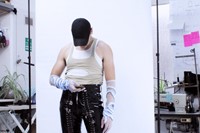Alongside a series of self-portraits taken in his east London studio, Irish designer and Fashion East alumnus Rory Parnell Mooney explains his new collection in his own words
In June of last year, Irish designer Rory Parnell Mooney – an alumnus of the Central Saint Martins Fashion Masters – announced a return to his eponymous label, Parnell Mooney, having taken a hiatus after showing for four seasons as part of Fashion East, beginning in 2015. “Maybe I want to teach, maybe I want to make money, maybe I want to have a life outside of fashion,” he told Another Man at the time. “But then it came down to wanting to still make clothes. And I think now I’ve realised you can do both.”
He set out in a new east London studio making collections on his own terms: released from the pressure of creating collections for a given moment, he took time to perfect singular garments, working organically and by instinct (an initial collection, produced for Autumn/Winter 2018, was held off until he “had something he believed in”). It is a way of working which has placed him in good stead for the events of the past six months, whereby the fashion industry has been forced to contemplate its future amid worldwide lockdowns, postponed fashion shows and shuttered stores. He, like a growing number of young, agile designers in the city, has found the unfolding events have afforded him a newfound freedom, envisaging a way of working outside the system which previously felt like it was never going to change.
“It was so nice to make something with no end in sight,” Parnell Mooney says of the process of creating his Spring/Summer 2021 collection, which is revealed exclusively on AnOthermag.com this morning (afterwards, it will become part of London Fashion Week’s digital platform). “[Lockdown] meant making clothes that felt better on me; trying everything on, getting really hands on in the making and constructing of everything, personally making a sample from start to finish, questioning your own decisions and adapting as you go. It was just a flow.”
As such, the collection is shown as a series of self-portraits, taken amid the everyday jumble of his own working studio in London’s Stratford. Like his previous work, it is fuelled by juxtapositions: everyday garments – the baggy work shirt, classic denim jeans, “office” tailoring – are, as the notes read, “dressed up and turned on”. Garments might be sliced away to expose flesh or laced-up, like the fastenings on a corset (the corset is a recurring motif in the collection, inspired by watching Céline Sciamma’s 2019 movie, Portrait of a Lady on Fire earlier this year), and come in a heady mix of fabrics, from patent faux-leather, mock croc and leopard print, to gauzy cotton and cornflower-blue satin, with delicate folds of the latter adorning a pair of sheer opera gloves.
“I want everything to have this duality to it,” Parnell Mooney says. “When I was making the collection, I was listening to Vivaldi one minute and Rammstein and Nina Hagen the next. I feel like the clothes should appeal to complicated people, who have loads of different sides to their identities. The motto is really ‘and’, rather than ‘or’.”
Here, as a new type of Fashion Week begins in London, Parnell Mooney tells the story behind the collection, in his own words.
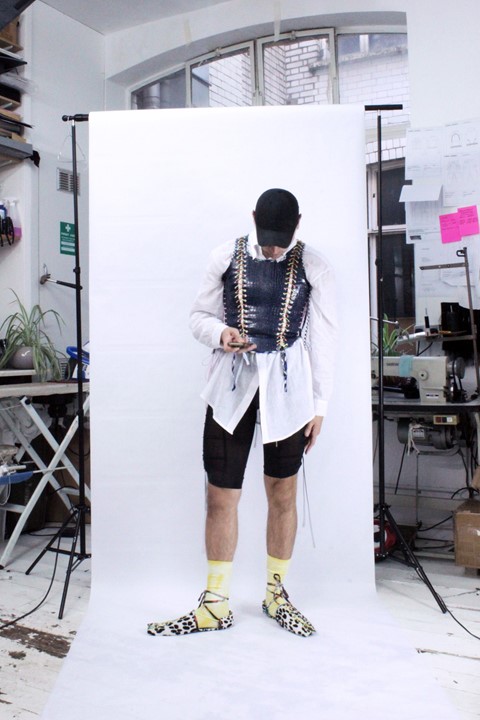
“When I was doing shows before, I was very easily able to say: this is what the show is about, this is the reference, here is the Balenciaga dress I was looking at for volume, or this picture of a nun, or goth, or whatever. The story of the collection in a soundbite. The previous way of working is restrictive: now, it’s so much more fluid, and nuanced. I don’t see collections as having a beginning or an end point – there’s ten pieces I didn’t shoot this time, and that will just be the start of next season. Evolution is a nice way to think of it – the first season back I was looking at Cruising as a reference, then there’s another layer of something the next time; each thing takes something from last season and moves another thing forward.
“With this season, it comes from a bit of a dragnet of everything I’ve been watching and listening to in lockdown. Derek Jarman’s Caravaggio, Portrait of a Lady on Fire, re-watching Twin Peaks – the weirdness, uncomfortableness in David Lynch films, an uneasy mixing of things. Videos of Carlos Acosta, and other male ballet principles; their combination of both strength and beauty. Music was so important, too: I’ve been listening to a lot of Baroque music because of Portrait of Lady on Fire, like Purcell, Monteverdi ... Music helps build a world around the thing I’m doing; I’m always listening on headphones, so it’s quite intense. That’s where the cornflower blue satin, and the corsets, came in – they fit into that same world. But then I would listen to Klaus Nomi operas, Rammstein, Nina Hagen, and I’d maybe start thinking about the pleather pieces. It helps set off a chain of thought.
“I think it’s really elevated from before – it’s smarter, it feels more grown up. There’s definitely like a play on an ‘office’ wardrobe, the ‘adult’ shirt, tailored trousers, a suit jacket – weirder versions of those pieces, but those were the starting points. Fitting everything on myself, I feel like I have a deeper connection with the clothes, the way they fit, they feel a bit more involved. It’s also made me feel more skilled as a maker: there was no option to have a factory make pieces, I couldn’t put stuff off. Sometimes necessity made things better: the corset was made from scrap fabric, everything it’s made from is scrap. This season it was more about looking and thinking: how can I do this? Not being able to get thing you wanted, and challenging yourself to use the things you have, or can find. Most of the time the end result was cooler.
“I would hope people wearing this collection would feel in total control. Confident, powerful. I wanted to explore the grey areas between masculine and feminine: how one day you might want to put on something more masculine, because it’s how you feel, or something more feminine the next day, however you might identify. It’s not saying this is men’s brand, or this is a women’s brand. There’s so many nice grey areas when we perform our identities. People don’t need to choose. I want people to feel good, to show off. That’s what the manifestation of the brand is: what I think people want to put on and go out and show off in. I don’t think there are many other brands making clothes for men with an eye for sex appeal. I think that’s important, otherwise it becomes really cerebral – that isn’t the point for me. I often work with pieces – jeans, lumberjack shirts, pleather trousers – which have been co-opted by queer men, and then twisting that. I don’t think I’m really seeing that much on catwalks.
“The good thing to have come out of lockdown is that all of the unnecessary stuff isn’t happening. It’s given people pause to be like, ‘oh, I don’t need to fly around the world 5,000 times for fashion shows’. Hopefully we will start to question that system a bit more, from loads of angles – diversity, sustainability, mental health. It has given more time to consider things that are actually important: if you are working at the industry pace we were last year you don’t have enough time to ask yourself really valid questions about who and what your brand represents. Maybe Covid has made the industry understand how much time is needed to do something with integrity; how long it takes to make something of worth; how long it takes to see an idea through from seed to fruition. The time it takes to build something meaningful, that lasts.”
